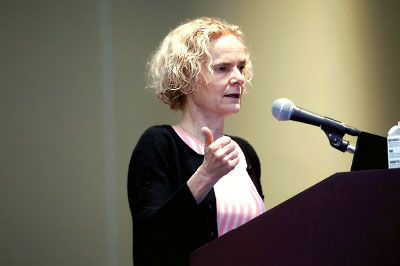NIDA Director Outlines Institute’s Efforts to Understand Pain, Reduce Opioid Misuse
Abstract
Nora Volkow, M.D., discussed NIDA’s role in NIH’s $500 million Helping to End Addiction Long-Term Initiative, including a new community-based implementation study launching this summer in four states.
Near the start of a presidential lecture at APA’s 2019 Annual Meeting on new advances in pain management and addiction, National Institute on Drug Abuse (NIDA) Director Nora Volkow, M.D., described her experience of going through opioid withdrawal.

While physicians have multiple pharmacological options for opioid use disorders, Nora Volkow, M.D., tells attendees that NIDA is committed to finding new treatment strategies and expanding the options for existing medications. One of these is methadone, which still needs to be taken on a daily basis.
During a brief hospital stay following a car accident, Volkow received Demerol for her pain. Upon returning home, she decided to stop taking this opioid out of an abundance of caution. Later that night, after she became severely restless, she remembered that the body becomes biologically dependent on opioids quickly, and an abrupt stop will trigger uncomfortable withdrawal symptoms. “I ignored all my knowledge about opioids and became ill,” she said.
Even in a stable state of mind, “I ignored all my knowledge about opioids and became ill,” she said.
Such an encounter reinforces how powerful opioids can be, Volkow said, and why programs like the National Institutes of Health (NIH) Helping to End Addiction Long-Term (HEAL)
Initiative are crucial.
Launched by Congress in April 2018, HEAL will provide over $500 million to NIH this year to improve pain management and find better treatments for opioid misuse and addiction.
“We need new treatments, and through HEAL we are incentivizing pharmaceutical companies to make pain relief a priority area of research,” Volkow said. Further, NIDA is using HEAL resources to expand and enhance its national Clinical Trials Network to help researchers find participants and initiate large clinical trials needed for drug approval. NIDA is also coordinating with the Food and Drug Administration to help expedite the review of promising medications.
Regarding opioid misuse, Volkow said, the good news is that multiple effective pharmacologic treatments are available in a range of formulations. NIDA is not content with the status quo, however. “We need to continue to diversify our current arsenal,” she said. One priority area she noted is methadone, which still needs to be taken once daily and only at approved methadone clinics.
“If someone like me can have trouble remembering to take a daily antibiotic, imagine being a person in drug recovery who has to travel a long distance every day to get methadone,” she said. “If we could develop a longer-acting methadone or a formulation with less risk of diversion that could be taken at home, we would help many patients stay compliant.”
Volkow also highlighted NIDA’s efforts to explore electrical and magnetic stimulation as tools to modulate brain pathways involved in reward processing; this might help reduce anxiety or other behaviors that contribute to the risk of relapse. NIDA researchers are also testing antibodies as a therapeutic relapse strategy. Antibodies can bind to drugs like heroin in the bloodstream and prevent them from entering the brain. Volkow said that preliminary studies suggest this approach can be effective, but current antibodies don’t last long after injection. Some new techniques used in HIV research make antibodies last up to six months, and NIDA is trying to replicate that feat.
Volkow wrapped up the session with a look at NIDA’s most ambitious HEAL-related projects to date. The first is a study known as HEALing Communities, which launched earlier this year. While there have been several advancements in treating opioid use disorder (OUD) in the past few years, she said, they have been conducted in specific settings—for example, a hospital emergency department or a jail. “Can we integrate effective OUD care across multiple health care, forensic, and community settings?” she asked.
Through this new study, research centers in four states—Kentucky, Massachusetts, New York, and Ohio—will try and implement a set of evidence-based strategies to reduce overdoses, decrease OUD prevalence, increase access to OUD medications, and get more people into recovery-support services; this implementation will be attempted in multiple counties, both urban and rural, in each state.
Another NIDA effort that will begin enrolling participants this summer is the Healthy Brain and Child Development Study (HBCD). This study will enroll pregnant women across the country and follow these women and their babies for 10 years to assess newborn brain development. Researchers hope to heavily recruit women with OUD as part of this project, to assess the long-term, transgenerational effects of addiction. HBCD will be a companion to NIH’s ongoing Adolescent Brain Cognitive Development Study (ABCD), which is following children aged 9 and 10 for a decade to assess brain development during adolescence and young adulthood.
“I really like HEAL because this initiative is more than simply stemming the current opioid crisis,” Volkow said, stressing the use of the phrase “long-term” in the HEAL name. “This initiative will give us the tools to change the trajectory of how we treat all addictions.” ■



